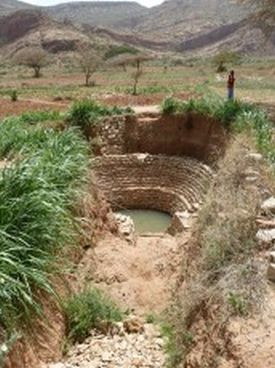 Karen Villholth, Principal Researcher – Groundwater Management, International Water Management Institute (IWMI), and Shilp Verma, PhD Fellow, UNESCO-IHE Institute for Water Education, represented the International Water Management Institute (IWMI) at the flagship event on ‘Groundwater in Africa’ in connection with World Water Day, hosted by the Water Policy Programme of the Overseas Development Institute (ODI).
Karen Villholth, Principal Researcher – Groundwater Management, International Water Management Institute (IWMI), and Shilp Verma, PhD Fellow, UNESCO-IHE Institute for Water Education, represented the International Water Management Institute (IWMI) at the flagship event on ‘Groundwater in Africa’ in connection with World Water Day, hosted by the Water Policy Programme of the Overseas Development Institute (ODI).
This event, held on March 21, 2014, and co-hosted by the Global Water Initiative (GWI), East Africa, and University of East Anglia (UEA) Water Security Research Centre (WSRC), UK, brought together international experts from a range of disciplines and sector perspectives to discuss four key themes: The groundwater resource perspective, the agriculture perspective, the development and poverty perspective, and lessons from the Asian perspective. The meeting was aimed at exploring options for managing water more effectively in the agriculture sector, with emphasis on finding means of accessing groundwater which can act as a buffer in the dry season and during years of poor rainfall. The meeting was also aimed at defining the role that groundwater can play in securing future agricultural growth and food security. The theme of the event was ‘From ground to growth’.
Shilp presented the rise and fall of the groundwater irrigation economy in India. The presentation provided a glimpse of the groundwater economy in India, how it has evolved into a ‘colossal anarchy’, the groundwater governance experiments being carried out in India, the energy-groundwater nexus and the relevance of the Indian experience for groundwater development policies in sub-Saharan Africa (SSA).
Explaining how the irrigation systems have evolved from being completely riverine in the early 1800s to state-controlled irrigation between 1830 and 1970, Shilp mentioned how groundwater irrigation gained steam in India in the post-1970s period due to the availability of cheap drilling technologies.
Since the 1970s, India has left all the other countries lagging behind to become the largest groundwater user. Approximately 80% of the groundwater is used for irrigation, and the remainder is used for municipal and industrial purposes. Shilp highlighted that the spread of groundwater structures in India has been driven more by demand rather than the availability of water. He provided the example of eastern India which has the best aquifer system in the country, but farmers find themselves unable to irrigate due to the lack of access to electricity.
Shilp elaborated the term ‘colossal anarchy’ which comes from the fact that India has around 20-25 million groundwater structures, the highest in the world. However, the amount of water extracted from these structures is among the lowest. With around 50-60% of the population dependent on groundwater and due to the large number of people, it becomes a difficult task for the government to manage and control extraction of this resource. However, steps are being taken to manage this resource more efficiently by managing the energy-groundwater nexus, promoting community-driven water harvesting and groundwater recharge movement. He provided the example of Gujarat, where intelligent rationing of power helped to boost crop yields.
It can be said that the groundwater ecology in India has undergone four distinct phases. The first phase was when the government convinced farmers to use groundwater through the use of public tube wells. Once the farmers were convinced, they started making their own investments and this led to the second phase – an increase in motor-pump irrigation. In phase three, externalities of overdevelopment started appearing with the lowering of the water table and over-extraction becoming commonplace. Finally, phase four included resource management regimes, where the government and the people have tried to overcome the negative externalities of over-exploitation, and have started finding innovative ways to managing this resource. Different parts of India are in different stages of groundwater development, with most parts being in phase three.
Contextualizing the learnings from India, Shilp elaborated that SSA is just getting into the first phase with studies indicating the huge potential of groundwater irrigation. As it evolves, SSA’s groundwater economy will: (a) be driven by resource-poor smallholder farmers; (b) involve a sizeable chunk of the local population; and (c) depend on complex hard-rock aquifer systems. Peninsular India is a unique learning ground for SSA, because it is the world’s only large land area that shares all these features and has witnessed the full aftereffects of a groundwater boom (good and bad). There are some pockets of positive experiences to imbibe and adapt. However, of particular importance for SSA are the lessons learned about the errors of omission and commission in hard-rock areas, which India wishes it had not made 50 years ago.
[hr top=”yes”/]
For further information, contact: shilpv@gmail.com
Link to the presentation – http://www.odi.org.uk/events/3871-world-water-day-groundwater-food-security

